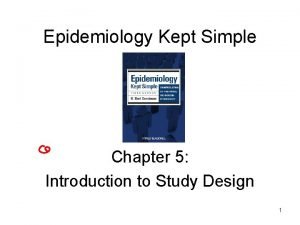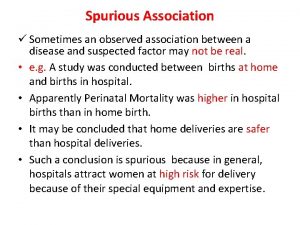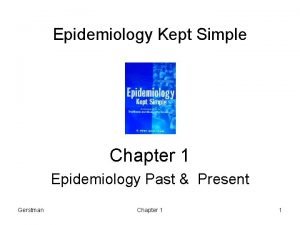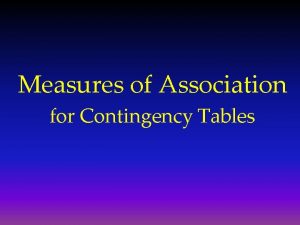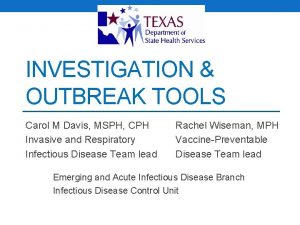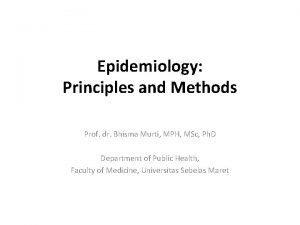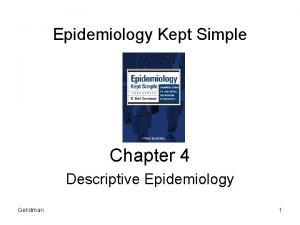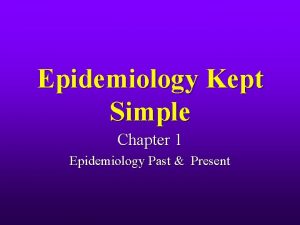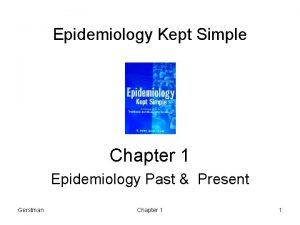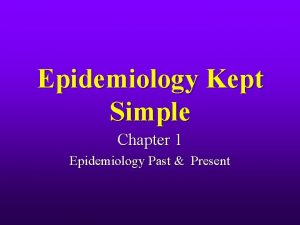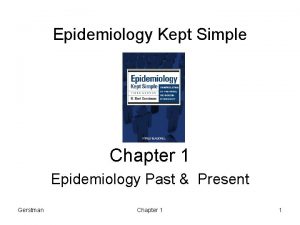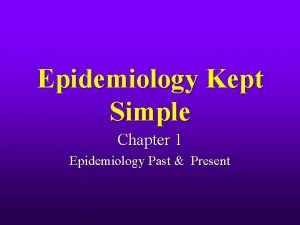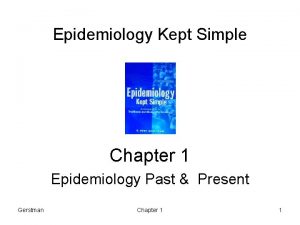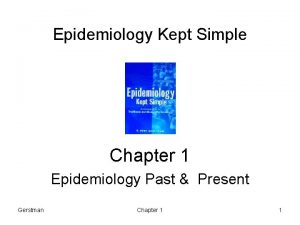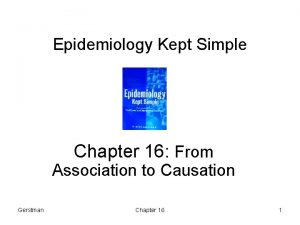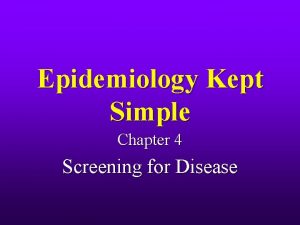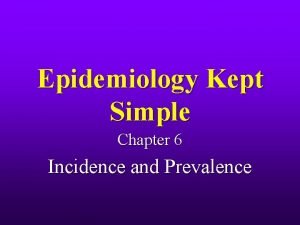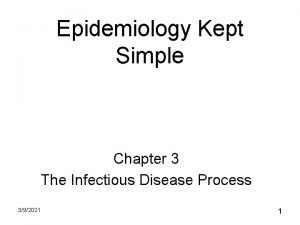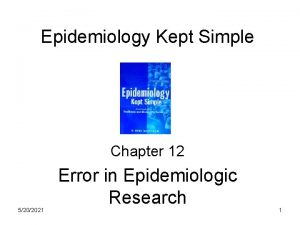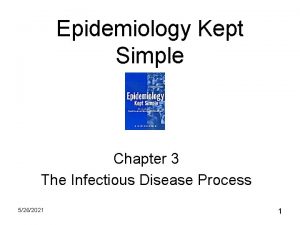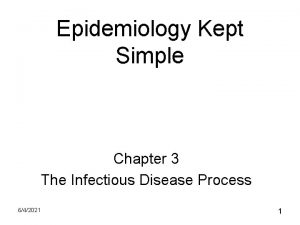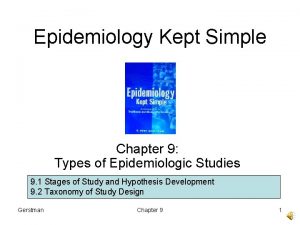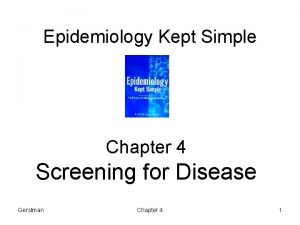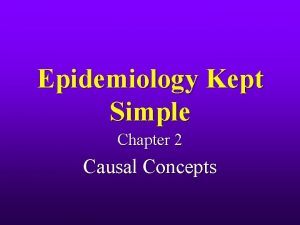Epidemiology Kept Simple Chapter 8 Measures of Association



























- Slides: 27

Epidemiology Kept Simple Chapter 8 Measures of Association & Potential Impact Gerstman Chapter 8

Important Jargon • Exposure (E) an explanatory factor; any potential health determinant; the independent variable • Disease (D) the response; any health-related outcome; the dependent variable • Measure of association (syn. measure of effect) a statistic that quantifies the relationship between an exposure and a disease • Measure of potential impact a statistic that quantifies the potential impact of removing a hazardous exposure Gerstman Chapter 8 2

Arithmetic (αριθμός) Comparisons • Measures of association are mathematical comparisons • Mathematic comparisons can be done in absolute terms or relative terms • Let us start with this ridiculously simple example: • I have $2 • You have $1 Gerstman Chapter 8 "For the things of this world cannot be made known without a knowledge of mathematics. "- Roger Bacon 3

Absolute Comparison • In absolute terms, I have $2 – $1 = $1 more than you • Note: the absolute comparison was made with subtraction Gerstman Chapter 8 It is as simple as that… 4

Relative Comparison • Recall that I have $2 and you have $1. • In relative terms, I have $2 ÷ $1 = 2, or “twice as much as you” • Note: relative comparison was made by division Gerstman Chapter 8 5

Applied to Risks • Suppose, I am exposed to a risk factor and have a 2% risk of disease. • You are not exposed and you have a 1% risk of the disease. • Of course we are assuming we are the same in every way except for this risk factor. • In absolute terms, I have 2% – 1% = 1% greater risk of the disease • This is the risk difference Gerstman Chapter 8 6

Applied to Risks • In relative terms I have 2% ÷ 1% = 2, or twice the risk • This is the relative risk associated with the exposure Gerstman Chapter 8 7

Terminology For simplicity sake, the terms “risk” and “rate” will be applied to all incidence and prevalence measures. Gerstman Chapter 8 8

Risk Difference (RD) absolute effect associated with exposure where R 1 ≡ risk in the exposed group R 0 ≡ risk in the non-exposed group Interpretation: Excess risk in absolute terms Gerstman Chapter 8 9

Relative Risk (RR) relative effect associated with exposure or the “risk ratio” where R 1 ≡ risk in the exposed group R 0 ≡ risk in the non-exposed group Interpretation: excess risk in relative terms. Gerstman Chapter 8 10

Example Fitness & Mortality (Blair et al. , 1995) • Is improved fitness associated with decreased mortality? • Exposure ≡ improved fitness (1 = yes, 0 = no) • Disease ≡ death (1 = yes, 0 = no) • Mortality rate, group 1: R 1 = 67. 7 per 100, 000 p-yrs • Mortality rate, group 0: R 0 = 122. 0 per 100, 000 p-yrs Gerstman Chapter 8 11

Example Risk Difference What is the effect of improved fitness on mortality in absolute terms? The effect of the exposure (improved fitness) is to decrease mortality by 54. 4 per 100, 000 person-years Gerstman Chapter 8 12

Example Relative Risk What is the effect of improved fitness on mortality in relative terms? The effect of the exposure is to cut the risk almost in half. Gerstman Chapter 8 13

Designation of Exposure • Switching the designmation of “exposure” does not materially affect interpretations • For example, if we had let “exposure” ≡ failure to improve fitness • RR = R 1 / R 0 = 122. 0 / 67. 7 = 1. 80 (1. 8 times the risk in the exposed group (“almost double”) Gerstman Chapter 8 14

2 -by-2 Table Format Disease + Disease − Exposure + A 1 B 1 Exposure – A 0 B 0 Total M 1 M 0 Total N 1 N 0 N For person-time data: let N 1 ≡ person-time in group 1 and N 0 ≡ person -time in group 0, and ignore cells B 1 and B 0 Gerstman Chapter 8 15

Fitness Data, table format Fitness Improved? Yes No Died 25 32 Person-years --- 4054 2937 Rates per 10, 000 person-years Gerstman Chapter 8 16

Food borne Outbreak Example Exposure ≡ eating a particular dish Disease ≡ gastroenteritis Disease + Disease − Exposure + 63 25 Exposure – 1 6 Total 64 31 Gerstman Chapter 8 Total 88 7 95 17

Food borne Outbreak Data Exposure + Exposure – Total Disease + 63 1 64 Disease − 25 6 31 Total 88 7 95 Exposed group had 5 times the risk Gerstman Chapter 8 18

What do you do when you have multiple levels of exposure? Compare rates to least exposed “reference” group Lung. CA Rate (per 100, 000 person-years) Non-smoker (0) Light smoker (1) Mod. smoker (2) Heavy sm. (3) Gerstman 10 52 106 224 Chapter 8 RR 1. 0 (ref. ) 5. 2 10. 6 22. 4 20

The Odds Ratio Similar to a RR, but based on odds rather than risks • When the disease is rare, interpret the same way you interpret a RR • e. g. an OR of 1 means the risks are the same in the exposed and nonexposed groups D+ D− Total E+ A 1 B 1 N 1 E− A 0 B 0 N 0 Total M 1 M 0 N “Cross-product ratio” Gerstman Chapter 8 21

Odds Ratio, Example Milunsky et al, 1989, Table 4 NTD = Neural Tube Defect Folic Acid+ Folic Acid− NTD+ NTD− 10 39 10, 703 11, 905 Exposed group had 0. 29 times (about a quarter) the risk of the nonexposed group Gerstman Chapter 8 22

Measures of Potential Impact • These measures predicted impact of removing a hazardous exposure from the population • Two types – Attributable fraction in exposed cases – Attributable fraction in the population as a whole Gerstman Chapter 8 23

Attributable Fraction Exposed Cases (AFe) Proportion of exposed cases averted with elimination of the exposure Gerstman Chapter 8 24

Example: AFe RR of lung CA associated with moderate smoking is approx. 10. 4. Therefore: Interpretation: 90. 4% of lung cancer in moderate smokers would be averted if they had not smoked. Gerstman Chapter 8 25

Attributable Fraction, Population (AFp) Proportion of all cases averted with elimination of exposure from the population Gerstman Chapter 8 26

AFp equivalent formulas Gerstman Chapter 8 27

AFp for Cancer Mortality, Selected Exposures Exposure Tobacco Dietary Occupational Repro/Sexual Sun/Radiation Alcohol Pollution Medication Gerstman Infection Doll & Peto, 1981 30% 35% 4% 7% 3% 3% 2% 1% Chapter 8 10% Miller, 1992 29% 20% 9% 7% 1% 6% 2% - 28
 Epidemiology kept simple
Epidemiology kept simple Ukuran asosiasi adalah
Ukuran asosiasi adalah Spurious association in epidemiology
Spurious association in epidemiology Repeated-measures design
Repeated-measures design Kept simple past
Kept simple past Kept simple past
Kept simple past Lambda measure of association
Lambda measure of association Advantages and disadvantages of nutritional epidemiology
Advantages and disadvantages of nutritional epidemiology Logistic regression epidemiology
Logistic regression epidemiology Incidence density formula
Incidence density formula Descriptive vs analytic epidemiology examples
Descriptive vs analytic epidemiology examples Formula for attack rate
Formula for attack rate Thesourceagents
Thesourceagents Person place and time model in epidemiology
Person place and time model in epidemiology Difference between descriptive and analytical epidemiology
Difference between descriptive and analytical epidemiology Incidence vs prevalence
Incidence vs prevalence Bibliography of epidemiology
Bibliography of epidemiology Association vs causality
Association vs causality Attack rate epidemiology formula
Attack rate epidemiology formula Gate frame epidemiology
Gate frame epidemiology Biological plausibility
Biological plausibility فاطمة خليفة
فاطمة خليفة Defination of epidemiology
Defination of epidemiology Concept of epidemiology
Concept of epidemiology What is descriptive study in epidemiology
What is descriptive study in epidemiology Field epidemiology ppt
Field epidemiology ppt Bhisma murti
Bhisma murti Certification board of infection control and epidemiology
Certification board of infection control and epidemiology
